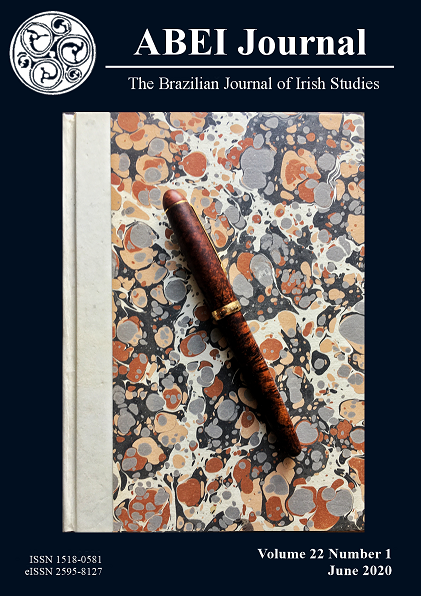Misanthropy of Form: John Banville’s Henry James
DOI:
https://doi.org/10.37389/abei.v22i1.3856Keywords:
John Banville, Mrs. Osmond, Henry James, The Portrait of A Lady, Misanthropy, Metafiction, BildungsromanAbstract
Mrs Osmond (2017) is unique to date among John Banville’s non-pseudonymous novels in having a female protagonist and no first-person voice. Reviewers have hailed it as a pastiche faithful to the style and dramatic situation of the classic work for which it offers a sequel, Henry James’s The Portrait of a Lady (1881). This essay argues that Mrs Osmond dismantles all the central elements of Portrait. Its manner of doing so shows the fundamental importance of a quality often observed in Banville’s male narrators—misanthropy—to the design of his novels, particularly its close connection to the aspect of his work most highlighted by scholars: metafictional self-reflexivity.
References
Banville, John. Ancient Light. Viking, 2012.
---. Athena. Secker and Warburg, 1995.
---. Birchwood. Secker and Warburg, 1973.
---. Eclipse. Picador, 2000.
---. Ghosts. Secker and Warburg, 1993.
---. Mefisto. Secker and Warburg, 1986.
---. Mrs Osmond. Viking, 2017.
---. Shroud. Vintage, 2002.
---. The Book of Evidence. Minerva, 1989
---. The Infinities. Picador, 2009.
---. The Revolutions Trilogy. Pan MacMillan, 2001.
---. The Sea. Picador, 2005.
---. The Untouchable. Picador, 1997.
Costello-Sullivan, Kathleen. Trauma and Recovery in the Twenty-First-Century Irish Novel. Syracuse University Press, 2018.
Deane, Seamus. “‘Be Assured I am Inventing’”: The Fiction of John Banville,” The Irish Novel in our Time ed. Patrick Rafroidi, Maurice Harmon, l’Université de Lille, 1976. 329-38.
D’hoker, Elke. “From Isabel Archer to Mrs Osmond: John Banville reinterprets Henry James,” John Banville and his Precursors, ed. Pietra Palazzolo, Michael Springer, and Stephen Butler, Bloomsbury Academic, 2019. 68-86.
D’hoker, Elke. Visions of Alterity: Representation in the Works of John Banville. Rodopi, 2004.
Doyle, Rob. “The Tides of Time.” The Times, December 18, 2016.
Eisenberg, Annika, “The Sound of L.A. Noir—Listening to Marlowe’s Los Angeles in Raymond Chandler’s The Long Goodbye and Benjamin Black’s The Black-Eyed Blonde,” Forum for Inter-American Research, 10.1 (May 2017): 13-27.
Foran, Charles. “Review: The Infinities,” The Globe and Mail, February 25, 2010.
Imhof, Rüdiger. John Banville: A Critical Introduction. Wolfhound Press, 1989.
James, Henry. Roderick Hudson. Novels, 1871-1880. Library of America, 1983.
---. The Golden Bowl. Novels, 1903-1911. Library of America, 2011.
---. The Portrait of a Lady. Modern Library, 2001.
---. The Princess Casamassima. Novels, 1886-1890. Library of America. 1989.
---. The Turn of the Screw. Norton, 1999.
---. The Wings of the Dove. Novels 1901-1902. Library of America, 2006.
Layne, Bethany. “Portraits and Palimpsests,” The Henry James Review, Volume 39:1 Winter 2018.
McMinn, Joseph. John Banville: A Critical Study. Dublin: Gill and Macmillan, 1991.
Moretti, Franco. The Way of the World: The Bildungsroman in European Culture. London: Verso, 1987.
Murphy, Neil. John Banville. Bucknell University Press, 2018.
O’Connell, Mark. John Banville’s Narcissistic Fictions: The Spectral Self. Palgrave Macmillan, 2013.
Springer, Michael. “The Limits of Simile: Rilke, Stevens and Banville’s Scepticism.” John Banville and his Precursors, ed. Pietra Palazzolo, Michael Springer, and Stephen Butler, Bloomsbury Academic, 2019. 127-145.
West, Rebecca. Henry James. London: Nisbet, 1916.
White, Edmund. “Mrs Osmond by John Banville – Superb Henry James Pastiche.” The Guardian, 14 October 2017.
Winter, Jessica. “Axel Prose.” The Village Voice, April 22, 2003.
Wood, Michael. “The Fantastic Fact.” London Review of Books, 40:1. January 2018.
Downloads
Published
Issue
Section
License
Copyright (c) 2020 Catherine Toal

This work is licensed under a Creative Commons Attribution-NonCommercial 4.0 International License.


